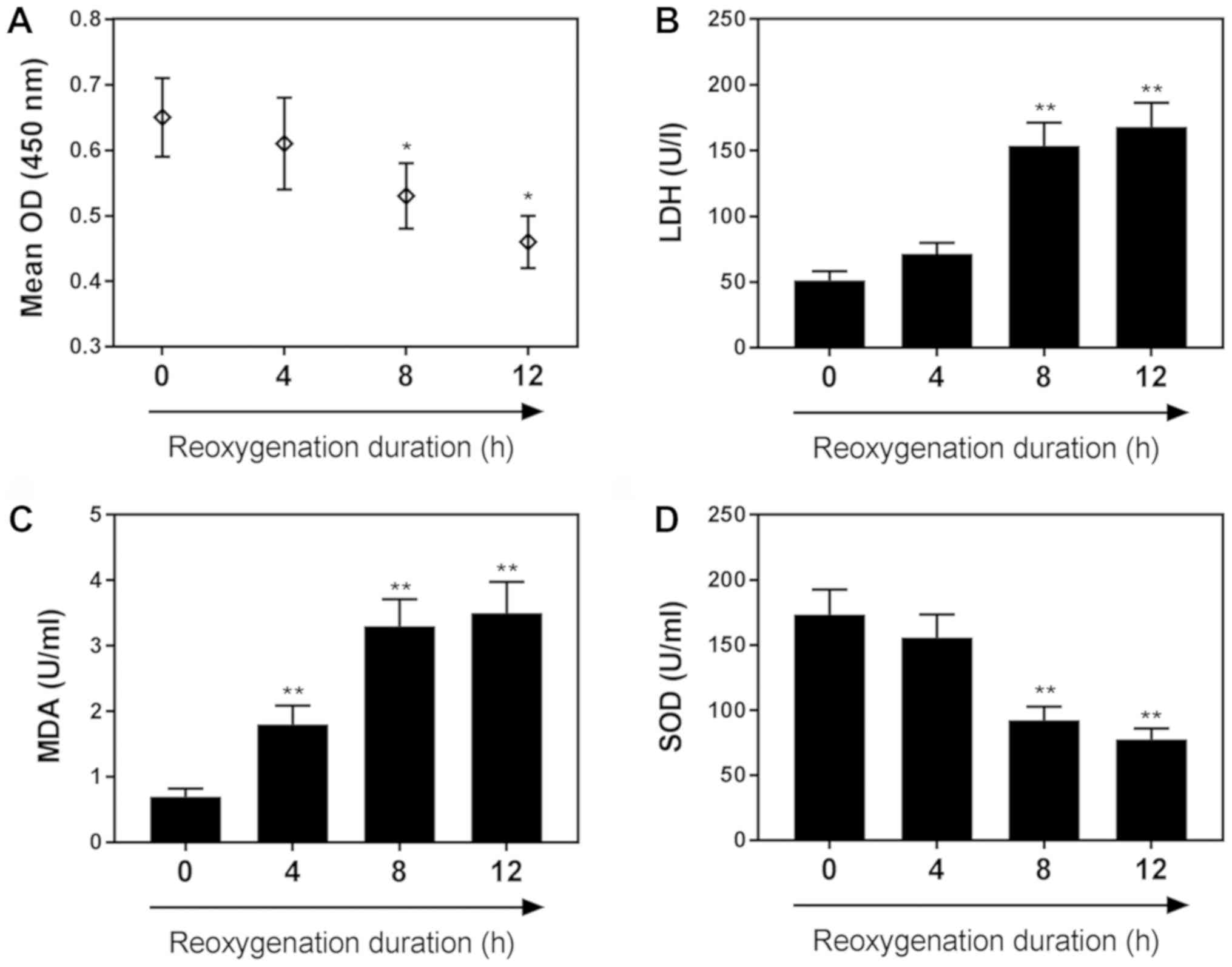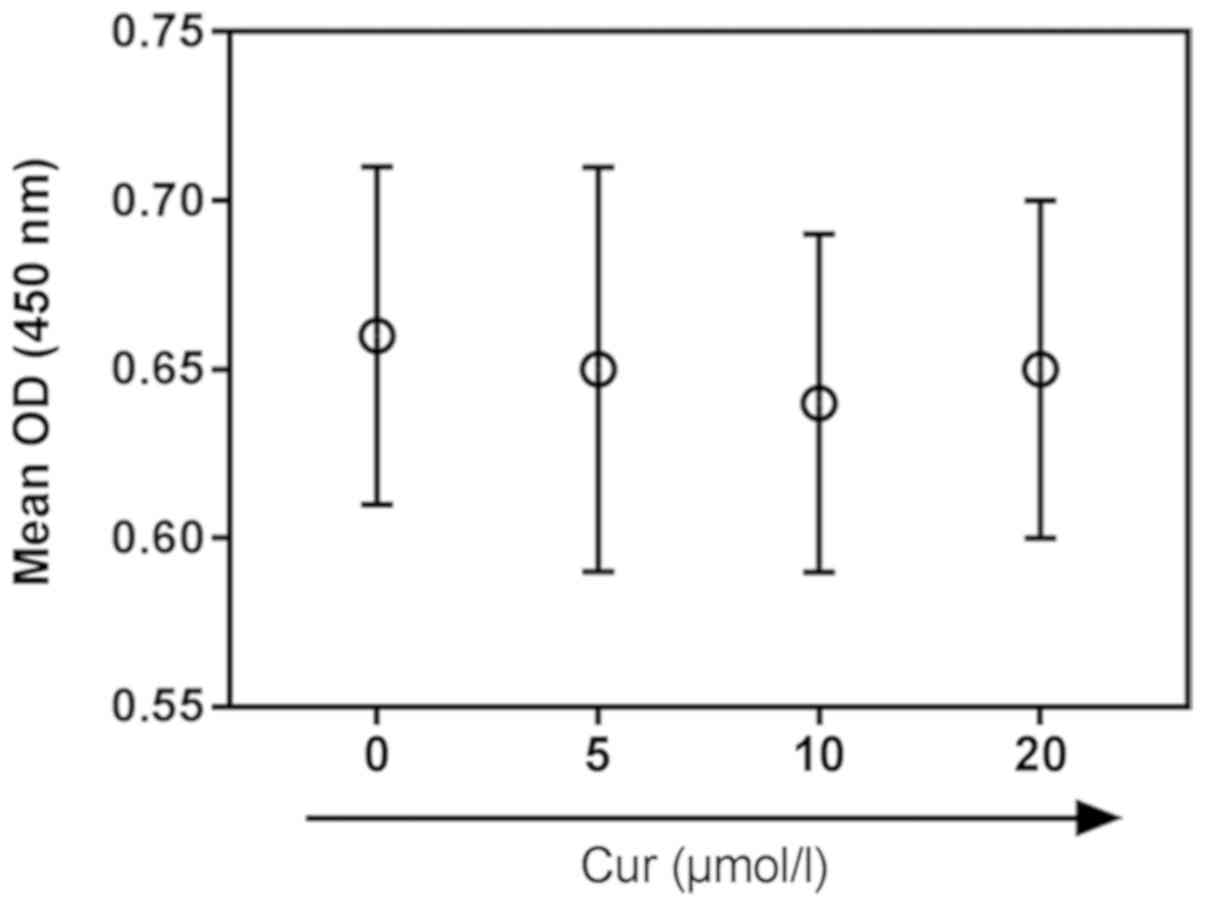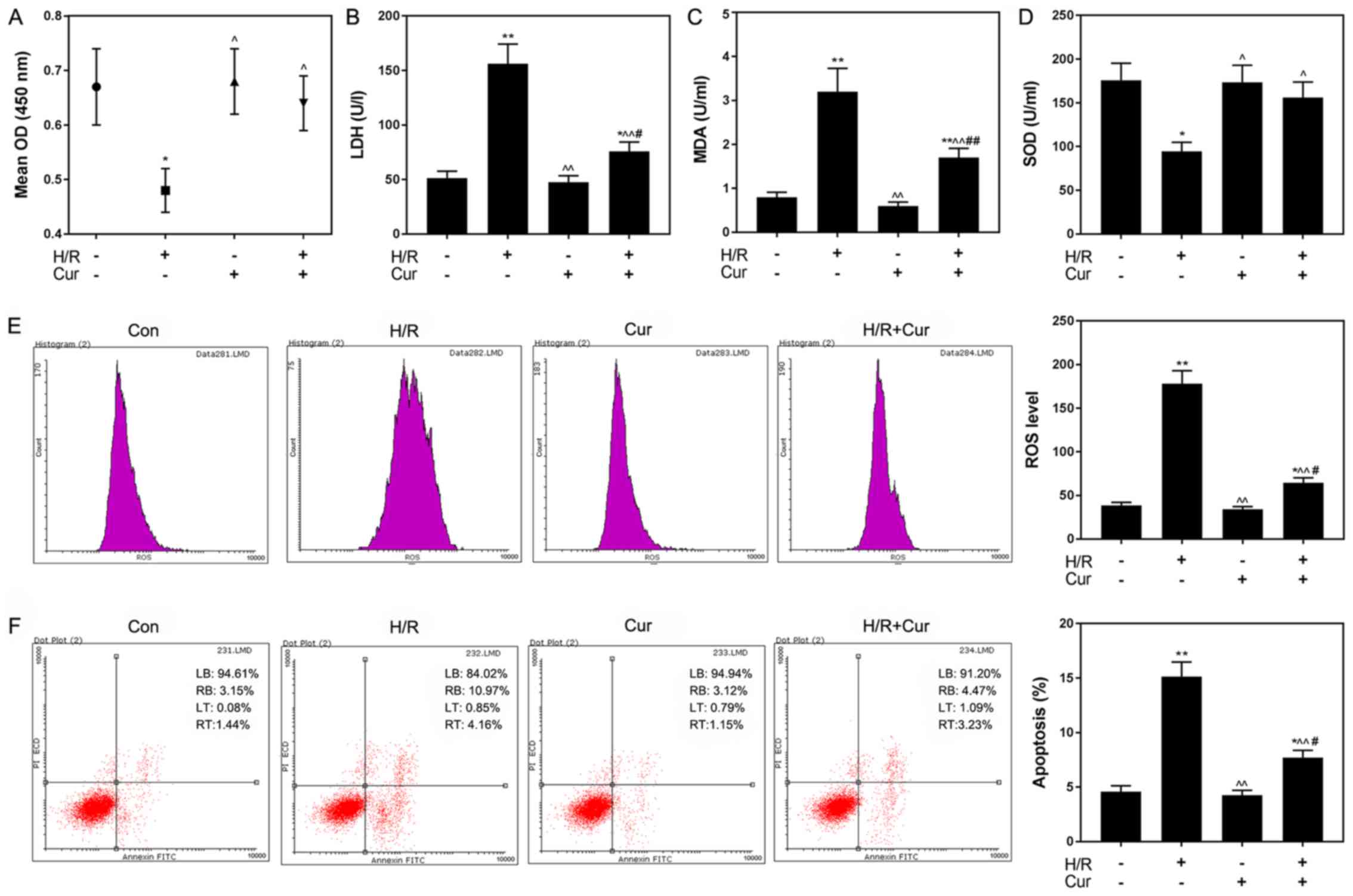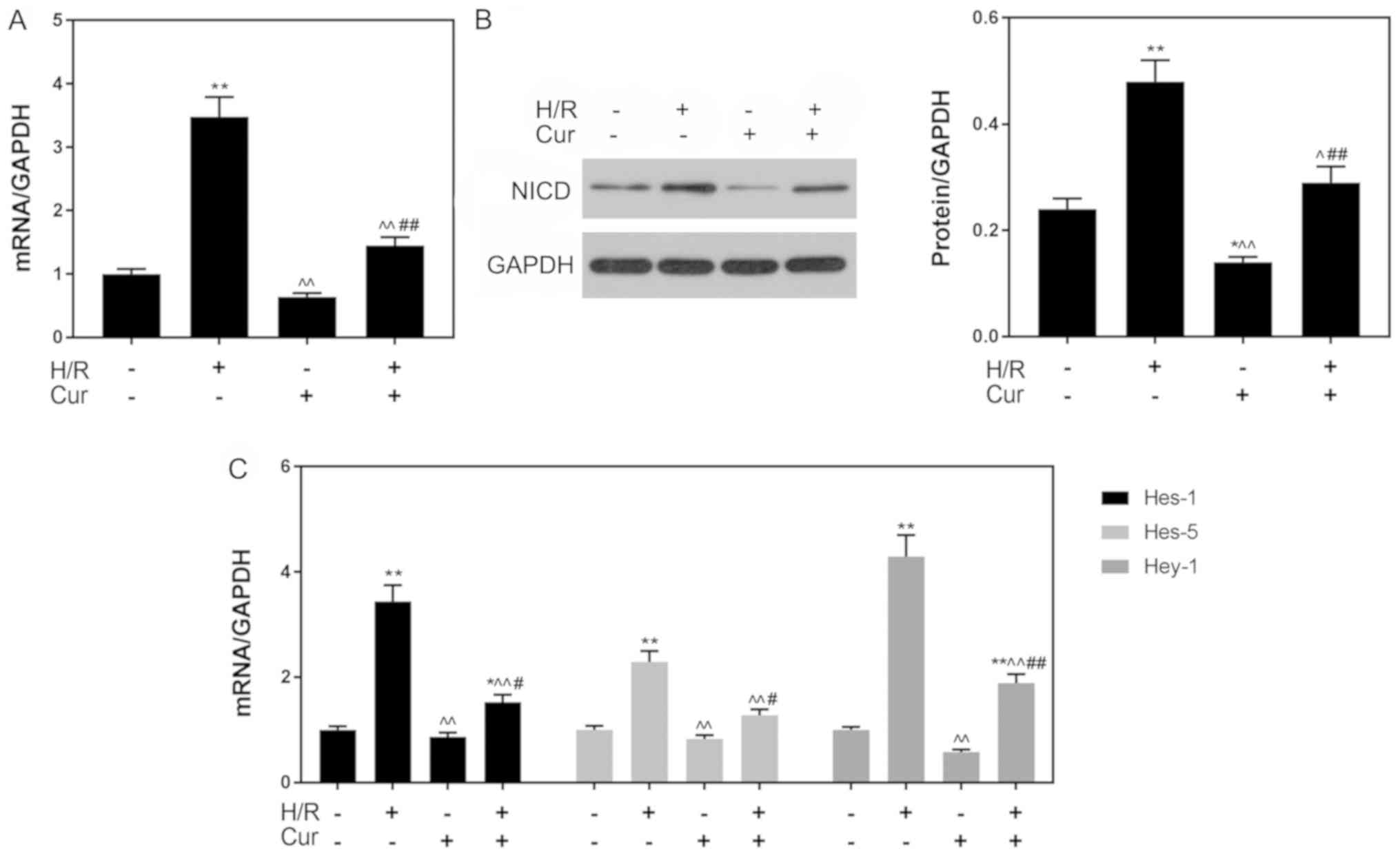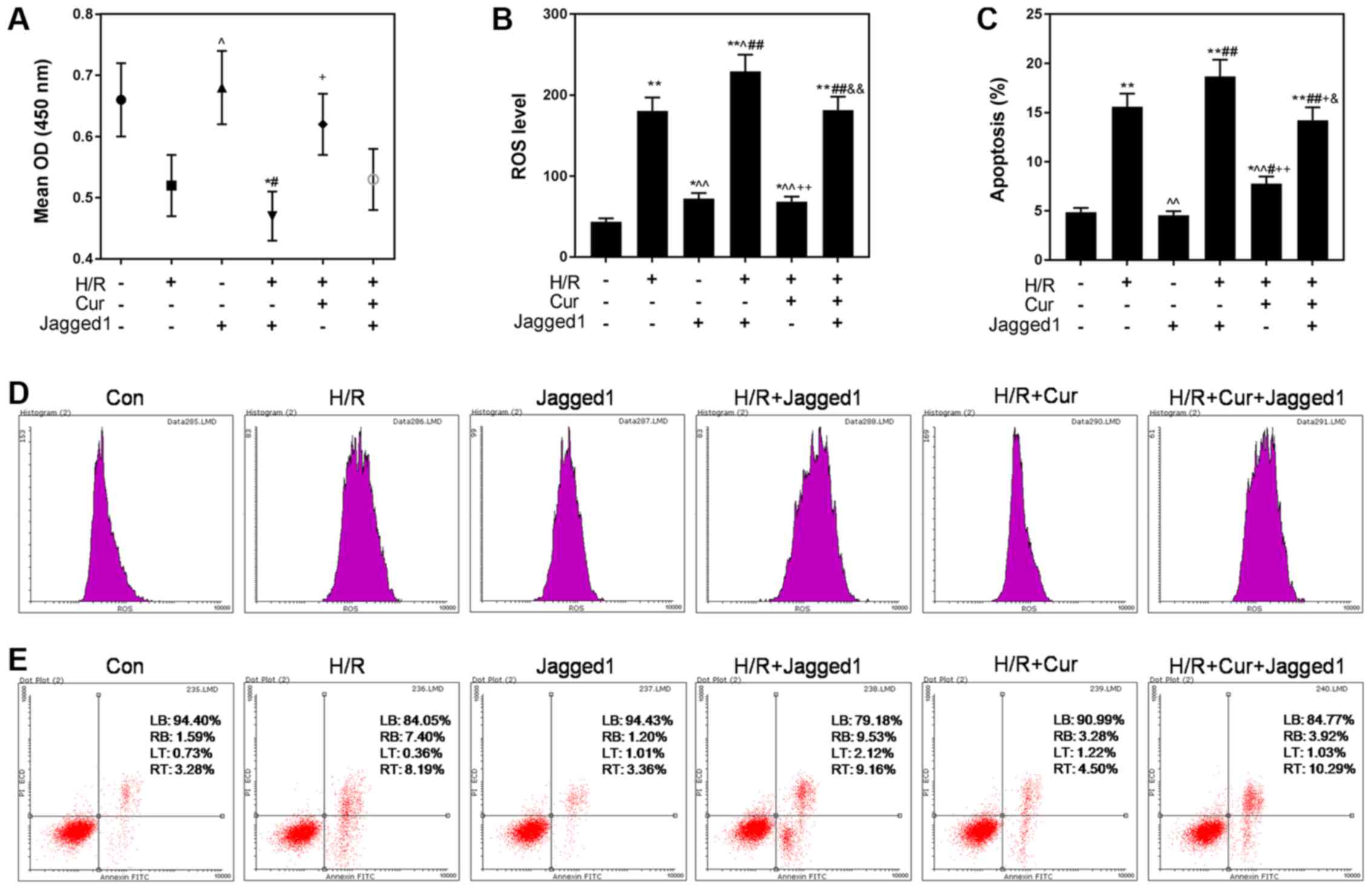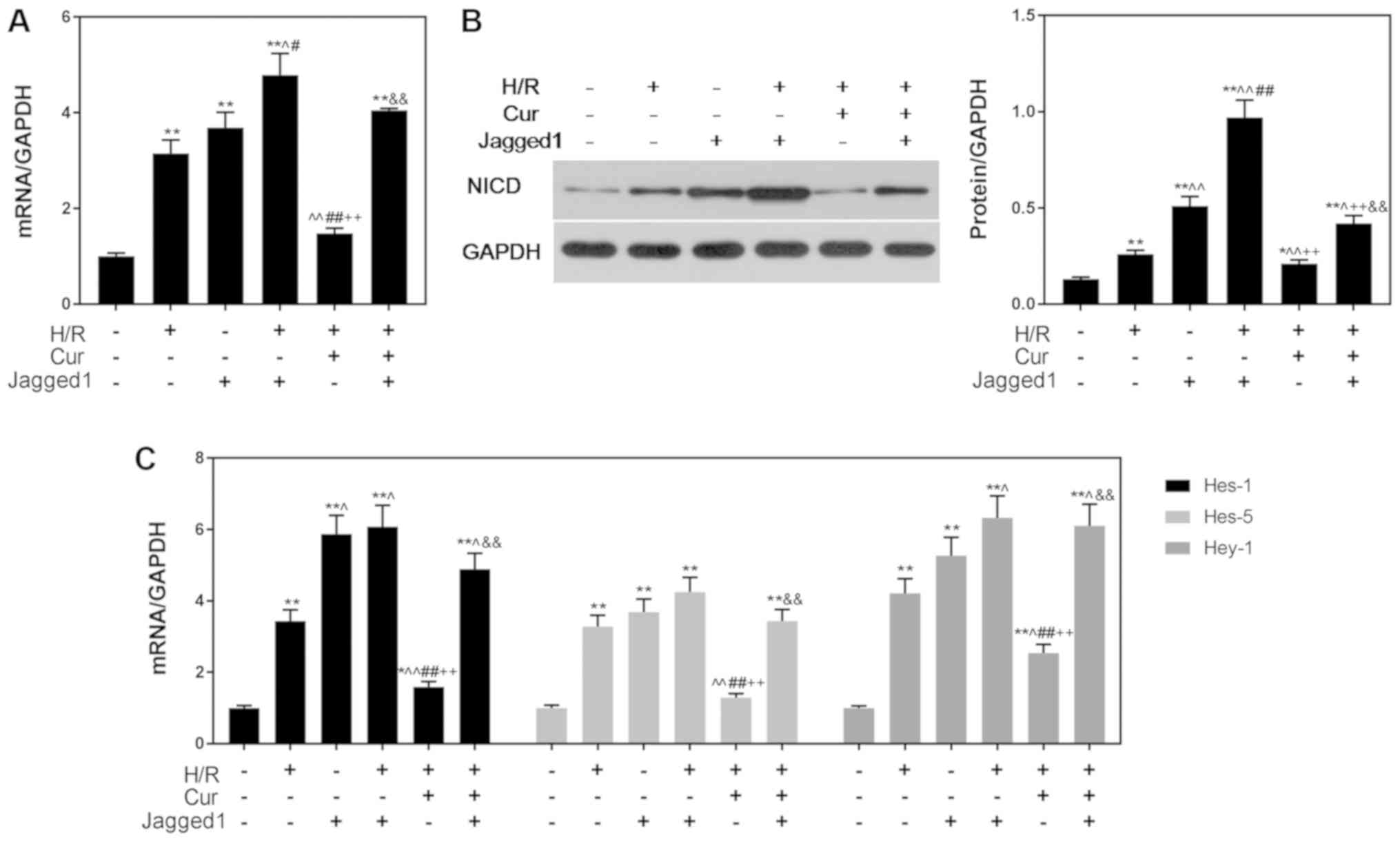|
1
|
Soriano JB, Rojas-Rueda D, Alonso J, Anto
JM, Cardona PJ, Fernandez E, Garcia-Basteiro AL, Benavides FG,
Glenn SD, Krish V, et al: The burden of disease in Spain: Results
from the global burden of disease 2016. Med Clin (Barc).
151:171–190. 2018.(In English, Spanish). View Article : Google Scholar : PubMed/NCBI
|
|
2
|
Bell MT, Puskas F, Agoston VA, Cleveland
JC Jr, Freeman KA, Gamboni F, Herson PS, Meng X, Smith PD, Weyant
MJ, et al: Toll-like receptor 4-dependent microglial activation
mediates spinal cord ischemia-reperfusion injury. Circulation. 128
(Suppl 1):S152–S156. 2013. View Article : Google Scholar : PubMed/NCBI
|
|
3
|
Hausenloy DJ and Yellon DM: Myocardial
ischemia-reperfusion injury: A neglected therapeutic target. J Clin
Invest. 123:92–100. 2013. View
Article : Google Scholar : PubMed/NCBI
|
|
4
|
Wang D, Chen TY and Liu FJ: Che-1
attenuates hypoxia/reoxygenation-induced cardiomyocyte apoptosis by
upregulation of Nrf2 signaling. Eur Rev Med Pharmacol Sci.
22:1084–1093. 2018.PubMed/NCBI
|
|
5
|
Bash J, Zong WX, Banga S, Rivera A,
Ballard DW, Ron Y and Gelinas C: Rel/NF-kappaB can trigger the
Notch signaling pathway by inducing the expression of Jagged1, a
ligand for Notch receptors. EMBO J. 18:2803–2811. 1999. View Article : Google Scholar : PubMed/NCBI
|
|
6
|
Artavanis-Tsakonas S, Rand MD and Lake RJ:
Notch signaling: Cell fate control and signal integration in
development. Science. 284:770–776. 1999. View Article : Google Scholar : PubMed/NCBI
|
|
7
|
Geisler F and Strazzabosco M: Emerging
roles of Notch signaling in liver disease. Hepatology. 61:382–392.
2015. View Article : Google Scholar : PubMed/NCBI
|
|
8
|
Luo J, Wang P, Wang R, Wang J, Liu M,
Xiong S, Li Y and Cheng B: The Notch pathway promotes the cancer
stem cell characteristics of CD90(+) cells in hepatocellular
carcinoma. Oncotarget. 7:9525–9537. 2016.PubMed/NCBI
|
|
9
|
Zavadil J, Cermak L, Soto-Nieves N and
Bottinger EP: Integration of TGF-beta/Smad and Jagged1/Notch
signalling in epithelial-to-mesenchymal transition. EMBO J.
23:1155–1165. 2004. View Article : Google Scholar : PubMed/NCBI
|
|
10
|
Cai W, Yang X, Han S, Guo H, Zhao Z, Wang
H, Guan H, Jia Y, Gao J, Yang T, et al: Notch1 pathway protects
against burn-induced myocardial injury by repressing reactive
oxygen species production through JAK2/STAT3 signaling. Oxid Med
Cell Longev. 2016:56389432016. View Article : Google Scholar : PubMed/NCBI
|
|
11
|
Kopan R and Ilagan MX: The canonical Notch
signaling pathway: Unfolding the activation mechanism. Cell.
137:216–233. 2009. View Article : Google Scholar : PubMed/NCBI
|
|
12
|
Cheng J, Wu Q, Lv R, Huang L, Xu B, Wang
X, Chen A and He F: MicroRNA-449a inhibition protects H9C2 cells
against hypoxia/reoxygenation-induced injury by targeting the
Notch-1 signaling pathway. Cell Physiol Biochem. 46:2587–2600.
2018. View Article : Google Scholar : PubMed/NCBI
|
|
13
|
Esatbeyoglu T, Huebbe P, Ernst IM, Chin D,
Wagner AE and Rimbach G: Curcumin--from molecule to biological
function. Angew Chem Int Ed Engl. 51:5308–5332. 2012. View Article : Google Scholar : PubMed/NCBI
|
|
14
|
Yeh CH, Chen TP, Wu YC, Lin YM and Jing
Lin P: Inhibition of NFkappaB activation with curcumin attenuates
plasma inflammatory cytokines surge and cardiomyocytic apoptosis
following cardiac ischemia/reperfusion. J Surg Res. 125:109–116.
2005. View Article : Google Scholar : PubMed/NCBI
|
|
15
|
Park BH, Lim JE, Jeon HG, Seo SI, Lee HM,
Choi HY, Jeon SS and Jeong BC: Curcumin potentiates antitumor
activity of cisplatin in bladder cancer cell lines via ROS-mediated
activation of ERK1/2. Oncotarget. 7:63870–63886. 2016. View Article : Google Scholar : PubMed/NCBI
|
|
16
|
Kunnumakkara AB, Bordoloi D, Padmavathi G,
Monisha J, Roy NK, Prasad S and Aggarwal BB: Curcumin, the golden
nutraceutical: Multitargeting for multiple chronic diseases. Br J
Pharmacol. 174:1325–1348. 2017. View Article : Google Scholar : PubMed/NCBI
|
|
17
|
Shen SQ, Zhang Y, Xiang JJ and Xiong CL:
Protective effect of curcumin against liver warm
ischemia/reperfusion injury in rat model is associated with
regulation of heat shock protein and antioxidant enzymes. World J
Gastroenterol. 13:1953–1961. 2007. View Article : Google Scholar : PubMed/NCBI
|
|
18
|
Yucel AF, Kanter M, Pergel A, Erboga M and
Guzel A: The role of curcumin on intestinal oxidative stress, cell
proliferation and apoptosis after ischemia/reperfusion injury in
rats. J Mol Histol. 42:579–587. 2011. View Article : Google Scholar : PubMed/NCBI
|
|
19
|
Liu F, Ni W, Zhang J, Wang G, Li F and Ren
W: Administration of curcumin protects kidney tubules against renal
ischemia-reperfusion injury (RIRI) by modulating nitric oxide (NO)
signaling pathway. Cell Physiol Biochem. 44:401–411. 2017.
View Article : Google Scholar : PubMed/NCBI
|
|
20
|
Wang L, Li N, Lin D and Zang Y: Curcumin
protects against hepatic ischemia/reperfusion induced injury
through inhibiting TLR4/NF-κB pathway. Oncotarget. 8:65414–65420.
2017.PubMed/NCBI
|
|
21
|
Kim YS, Kwon JS, Cho YK, Jeong MH, Cho JG,
Park JC, Kang JC and Ahn Y: Curcumin reduces the cardiac
ischemia-reperfusion injury: involvement of the toll-like receptor
2 in cardiomyocytes. J Nutr Biochem. 23:1514–1523. 2012. View Article : Google Scholar : PubMed/NCBI
|
|
22
|
Jha N, Mishra S, Mamidi A, Mishra A, Jha S
and Surolia A: Targeting Human Telomeric G- Quadruplexes DNA with
curcumin and its synthesized analogues under molecular crowding
condition. RSC Advances. 6:7474–7487. 2016. View Article : Google Scholar
|
|
23
|
Lin S, Gao W, Tian Z, Yang C, Lu L, Mergny
JL, Leung CH and Ma DL: Luminescence switch-on detection of protein
tyrosine kinase-7 using a G-quadruplex-selective probe. Chem Sci.
6:4284–4290. 2015. View Article : Google Scholar : PubMed/NCBI
|
|
24
|
Wang M, Mao Z, Kang TS, Wong CY, Mergny
JL, Leung CH and Ma DL: Conjugating a groove-binding motif to an
Ir(iii) complex for the enhancement of G-quadruplex probe behavior.
Chem Sci. 7:2516–2523. 2016. View Article : Google Scholar : PubMed/NCBI
|
|
25
|
Park M, Youn B, Zheng XL, Wu D, Xu A and
Sweeney G: Globular Adiponectin, acting via adipoR1/APPL1, protects
H9c2 cells from hypoxia/reoxygenation-induced apoptosis. Plos One.
6:e191432011. View Article : Google Scholar : PubMed/NCBI
|
|
26
|
Magalhães LG, Machado CB, Morais ER,
Moreira EB, Soares CS, Da SS, Da SFA and Rodrigues V: In vitro
schistosomicidal activity of curcumin against Schistosoma mansoni
adult worms. Parasitology Research. 104:1197–1201. 2009. View Article : Google Scholar : PubMed/NCBI
|
|
27
|
Gu Q, Cai Y, Huang C, Shi Q and Yang H:
Curcumin increases rat mesenchymal stem cell osteoblast
differentiation but inhibits adipocyte differentiation.
Pharmacognosy Magazine. 8:202–208. 2012. View Article : Google Scholar : PubMed/NCBI
|
|
28
|
Livak KJ and Schmittgen TD: Analysis of
relative gene expression data using real-time quantitative PCR and
the 2(-Delta Delta C(T)) method. Methods. 25:402–408. 2001.
View Article : Google Scholar : PubMed/NCBI
|
|
29
|
Yamamoto T and Sadoshima J: Protection of
the heart against ischemia/reperfusion by silent information
regulator 1. Trends Cardiovasc Med. 21:27–32. 2011. View Article : Google Scholar : PubMed/NCBI
|
|
30
|
Liu H, Jing X, Dong A, Bai B and Wang H:
Overexpression of TIMP3 protects against cardiac
ischemia/reperfusion injury by inhibiting myocardial apoptosis
through ROS/Mapks pathway. Cell Physiol Biochem. 44:1011–1023.
2017. View Article : Google Scholar : PubMed/NCBI
|
|
31
|
Liu K, Chen H, You QS, Ye Q, Wang F, Wang
S, Zhang SL, Yu KJ and Lu Q: Curcumin attenuates myocardial
ischemia-reperfusion injury. Oncotarget. 8:112051–112059. 2017.
View Article : Google Scholar : PubMed/NCBI
|
|
32
|
Wang R, Zhang JY, Zhang M, Zhai MG, Di SY,
Han QH, Jia YP, Sun M and Liang HL: Curcumin attenuates IR-induced
myocardial injury by activating SIRT3. Eur Rev Med Pharmacol Sci.
22:1150–1160. 2018.PubMed/NCBI
|
|
33
|
Yang Y, Duan W, Lin Y, Yi W, Liang Z, Yan
J, Wang N, Deng C, Zhang S, Li Y, et al: SIRT1 activation by
curcumin pretreatment attenuates mitochondrial oxidative damage
induced by myocardial ischemia reperfusion injury. Free Radic Biol
Med. 65:667–679. 2013. View Article : Google Scholar : PubMed/NCBI
|
|
34
|
Zhang L, Wei S, Tang JM, Guo LY, Zheng F,
Yang JY, Kong X, Huang YZ, Chen SY and Wang JN: PEP-1-CAT protects
hypoxia/reoxygenation-induced cardiomyocyte apoptosis through
multiple sigaling pathways. J Transl Med. 11:1132013. View Article : Google Scholar : PubMed/NCBI
|
|
35
|
Duan W, Yang Y, Yan J, Yu S, Liu J, Zhou
J, Zhang J, Jin Z and Yi D: The effects of curcumin post-treatment
against myocardial ischemia and reperfusion by activation of the
JAK2/STAT3 signaling pathway. Basic Res Cardiol. 107:2632012.
View Article : Google Scholar : PubMed/NCBI
|
|
36
|
Bagheri F, Khori V, Alizadeh AM,
Khalighfard S, Khodayari S and Khodayari H: Reactive oxygen
species-mediated cardiac-reperfusion injury: Mechanisms and
therapies. Life Sci. 165:43–55. 2016. View Article : Google Scholar : PubMed/NCBI
|
|
37
|
Jeong CW, Yoo KY, Lee SH, Jeong HJ, Lee CS
and Kim SJ: Curcumin protects against regional myocardial
ischemia/reperfusion injury through activation of RISK/GSK-3β and
inhibition of p38 MAPK and JNK. J Cardiovasc Pharmacol Ther.
17:387–394. 2012. View Article : Google Scholar : PubMed/NCBI
|
|
38
|
Zhou XL, Wan L and Liu JC: Activated
Notch1 reduces myocardial ischemia reperfusion injury in vitro
during ischemic postconditioning by crosstalk with the RISK
signaling pathway. Chin Med J (Engl). 126:4545–4551.
2013.PubMed/NCBI
|
|
39
|
Zhang S, Zhang R, Wu F and Li X:
MicroRNA-208a regulates H9c2 cells simulated ischemia-reperfusion
myocardial injury via targeting CHD9 through Notch/NF-kappa B
signal pathways. Int Heart J. 59:580–588. 2018. View Article : Google Scholar : PubMed/NCBI
|
|
40
|
Jing R, Zhou Z, Kuang F, Huang L and Li C:
microRNA-99a reduces lipopolysaccharide-induced oxidative injury by
activating Notch pathway in H9c2 cells. Int Heart J. 58:422–427.
2017. View Article : Google Scholar : PubMed/NCBI
|
|
41
|
Boccalini G, Sassoli C, Formigli L, Bani D
and Nistri S: Relaxin protects cardiac muscle cells from
hypoxia/reoxygenation injury: Involvement of the Notch-1 pathway.
FASEB J. 29:239–249. 2015. View Article : Google Scholar : PubMed/NCBI
|
|
42
|
Wang K, Ding R, Ha Y, Jia Y, Liao X, Wang
S, Li R, Shen Z, Xiong H, Guo J and Jie W: Hypoxia-stressed
cardiomyocytes promote early cardiac differentiation of cardiac
stem cells through HIF-1α/Jagged1/Notch1 signaling. Acta Pharm Sin
B. 8:795–804. 2018. View Article : Google Scholar : PubMed/NCBI
|
|
43
|
Kamei N, Kwon SM, Ishikawa M, Ii M,
Nakanishi K, Yamada K, Hozumi K, Kawamoto A, Ochi M and Asahara T:
Endothelial progenitor cells promote astrogliosis following spinal
cord injury through Jagged1-dependent Notch signaling. J
Neurotrauma. 29:1758–1769. 2012. View Article : Google Scholar : PubMed/NCBI
|
|
44
|
Wu X, Zou Y, Zhou Q, Huang L, Gong H, Sun
A, Tateno K, Katsube K, Radtke F, Ge J, et al: Role of Jagged1 in
arterial lesions after vascular injury. Arterioscler Thromb Vasc
Biol. 31:2000–2006. 2011. View Article : Google Scholar : PubMed/NCBI
|
|
45
|
Hu Y, Su H, Li X, Guo G, Cheng L, Qin R,
Qing G and Liu H: The NOTCH ligand JAGGED2 promotes pancreatic
cancer metastasis independent of NOTCH signaling activation. Mol
Cancer Ther. 14:289–297. 2015. View Article : Google Scholar : PubMed/NCBI
|
|
46
|
Francis JC, Radtke F and Logan MP: Notch1
signals through Jagged2 to regulate apoptosis in the apical
ectodermal ridge of the developing limb bud. Dev Dyn.
234:1006–1015. 2005. View Article : Google Scholar : PubMed/NCBI
|
|
47
|
Zhang H, Ye Y, Bai Z and Wang S: The COX-2
selective inhibitor-independent COX-2 effect on colon carcinoma
cells is associated with the Delta1/Notch1 pathway. Dig Dis Sci.
53:2195–2203. 2008. View Article : Google Scholar : PubMed/NCBI
|
|
48
|
Pelullo M, Quaranta R, Talora C, Checquolo
S, Cialfi S, Felli MP, te Kronnie G, Borga C, Besharat ZM, Palermo
R, et al: Notch3/Jagged1 circuitry reinforces notch signaling and
sustains T-ALL. Neoplasia. 16:1007–1017. 2014. View Article : Google Scholar : PubMed/NCBI
|
|
49
|
Weerateerangkul P, Chattipakorn S and
Chattipakorn N: Roles of the nitric oxide signaling pathway in
cardiac ischemic preconditioning against myocardial
ischemia-reperfusion injury. Med Sci Monit. 17:RA44–RA52. 2011.
View Article : Google Scholar : PubMed/NCBI
|
|
50
|
Zhu L, Ye T, Tang Q, Wang Y, Wu X, Li H
and Jiang Y: Exercise preconditioning regulates the toll-like
receptor 4/nuclear Factor-κB signaling pathway and reduces cerebral
ischemia/reperfusion inflammatory injury: A study in rats. J Stroke
Cerebrovasc Diseases. 25:2770–2779. 2016. View Article : Google Scholar
|
|
51
|
Zheng Y, Bu J, Yu L, Chen J and Liu H:
Nobiletin improves propofol-induced neuroprotection via regulating
Akt/mTOR and TLR 4/NF-κB signaling in ischemic brain injury in
rats. Biomed Pharmacother. 91:494–503. 2017. View Article : Google Scholar : PubMed/NCBI
|















